BlackRock Bundle
Who Really Controls BlackRock?
Unraveling the mystery of BlackRock's ownership is key to understanding its immense power in the financial world. Founded in 1988, this global asset management giant has evolved into a force that shapes markets and influences corporate governance. Discover the intricate web of BlackRock shareholders and their impact on the company's strategic direction.
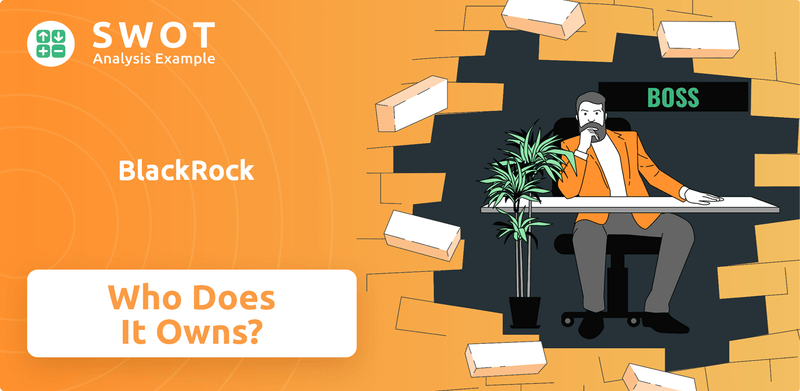
From its humble beginnings, BlackRock's BlackRock SWOT Analysis reveals a strategic evolution driven by its ownership structure. Understanding who owns BlackRock, including its major stakeholders and institutional investors, is crucial for anyone seeking to navigate the complexities of global finance. This exploration delves into the company's history, examining the influence of BlackRock executives and the dynamics that shape its investment strategy and financial performance. Knowing the largest shareholders list provides valuable insights.
Who Founded BlackRock?
In 1988, a group of eight partners from The First Boston Corporation came together to establish what would become a global financial powerhouse. These individuals, including Laurence Fink, Robert S. Kapito, and Susan Wagner, laid the groundwork for a company that would redefine the investment management landscape. Their collective vision and expertise were crucial in the early days of the firm.
The initial funding for this new venture came from Blackstone Group, which provided a $5 million line of credit. In return, Blackstone received a 50% stake in the company. This strategic partnership was instrumental in the early stages, providing the financial backing needed to launch and grow the business. The founders could focus on building their investment management capabilities.
While the exact equity splits among the founders at the beginning are not publicly detailed, the founding partners collectively held significant control. Early agreements likely included provisions for future equity offerings. The primary focus was on fixed income and risk management, attracting institutional clients. There were no widely reported initial ownership disputes, indicating a cohesive early period focused on establishing the firm's reputation.
The early ownership structure of the company was a blend of founder control and strategic investment. Brief History of BlackRock offers insights into the company's evolution. The founders, with their combined experience, drove the initial direction and strategy. The partnership with Blackstone provided essential financial support and a foundation for growth.
- The founders, including Laurence Fink, were key in shaping the company's culture and investment approach.
- Blackstone's initial investment was crucial for the company's early operations and expansion.
- The focus on fixed income and risk management attracted institutional clients, setting the stage for future growth.
- The early years were marked by a cohesive team effort, laying the groundwork for the company's future success.
BlackRock SWOT Analysis
- Complete SWOT Breakdown
- Fully Customizable
- Editable in Excel & Word
- Professional Formatting
- Investor-Ready Format
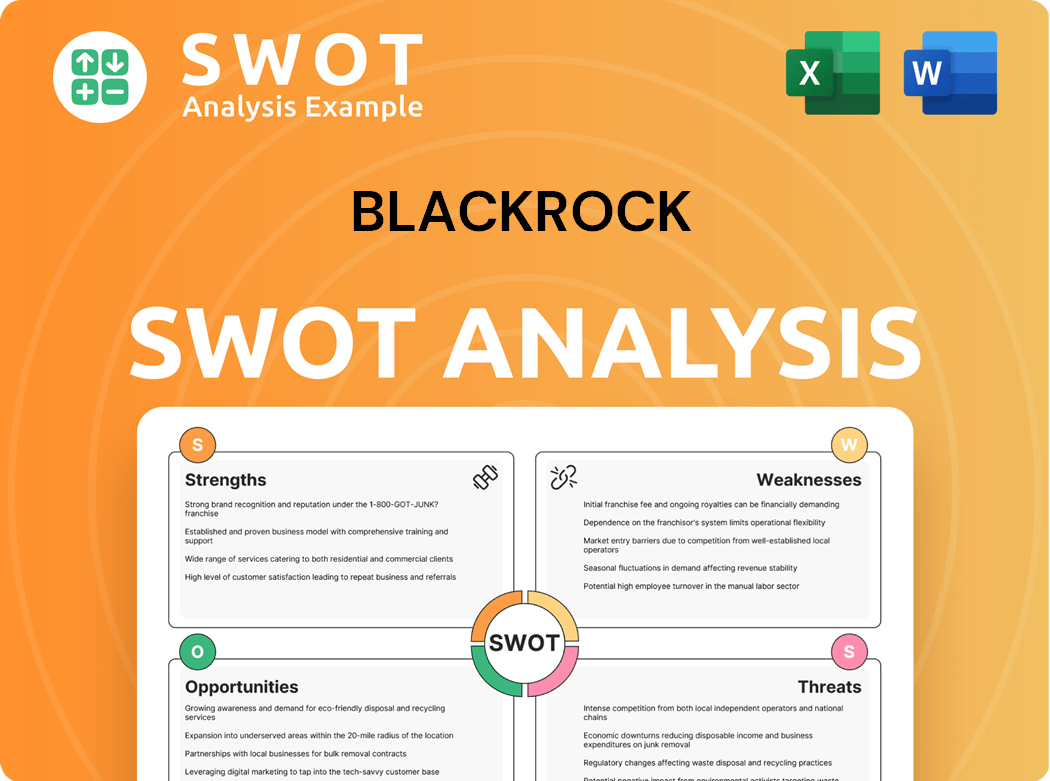
How Has BlackRock’s Ownership Changed Over Time?
The evolution of BlackRock's ownership is marked by key events that transformed its structure. Initially, the company's ownership was concentrated among its founders and Blackstone. The 1999 initial public offering (IPO) on the New York Stock Exchange was a watershed moment, broadening the shareholder base to include public investors. Strategic mergers and acquisitions further reshaped the ownership landscape. The acquisition of Merrill Lynch Investment Managers in 2006 and Barclays Global Investors (BGI) in 2009, which included the iShares ETF business, were particularly significant. These deals often involved stock components, integrating new institutional shareholders and diluting original stakes.
These acquisitions significantly expanded BlackRock's asset base and global reach. The integration of BGI, which included the iShares ETF business, was particularly transformative, solidifying BlackRock's position in the exchange-traded fund market. These events not only increased the company's assets under management but also altered its ownership dynamics, bringing in new institutional shareholders and reshaping the balance of power among stakeholders. The changes reflect the company's growth trajectory and its increasing influence in the global financial market. Understanding the history of BlackRock's ownership provides crucial insights into its current structure and strategic direction.
| Event | Year | Impact on Ownership |
|---|---|---|
| Initial Public Offering (IPO) | 1999 | Diversified ownership, opened to public shareholders |
| Acquisition of Merrill Lynch Investment Managers | 2006 | Expanded asset base, integrated new shareholders |
| Acquisition of Barclays Global Investors (BGI) | 2009 | Included iShares ETF business, significant expansion |
Currently, BlackRock's ownership is largely dominated by institutional investors. As of early 2024, major BlackRock shareholders include Vanguard Group Inc., holding a substantial percentage of shares, along with State Street Corporation and Capital Research Global Investors. These institutional investors, especially index fund providers, hold significant passive stakes, reflecting BlackRock's inclusion in major market indices. Institutional ownership consistently accounts for a vast majority of BlackRock's outstanding shares, often exceeding 80% to 85%. Larry Fink, as Chairman and CEO, along with other key BlackRock executives, holds smaller but still significant individual stakes, aligning their interests with the broader shareholder base. This institutional dominance influences BlackRock's long-term strategic decisions, particularly regarding capital allocation, governance, and shareholder returns. For more insights, you can explore the Competitors Landscape of BlackRock.
BlackRock's ownership structure has evolved significantly since its founding, transitioning from private to predominantly institutional ownership.
- The IPO in 1999 was a pivotal moment, opening the company to public shareholders.
- Major acquisitions, such as Merrill Lynch Investment Managers and Barclays Global Investors, expanded its asset base and shareholder structure.
- Institutional investors, including Vanguard and State Street, hold the majority of shares.
- Larry Fink and other executives maintain significant individual stakes.
BlackRock PESTLE Analysis
- Covers All 6 PESTLE Categories
- No Research Needed – Save Hours of Work
- Built by Experts, Trusted by Consultants
- Instant Download, Ready to Use
- 100% Editable, Fully Customizable
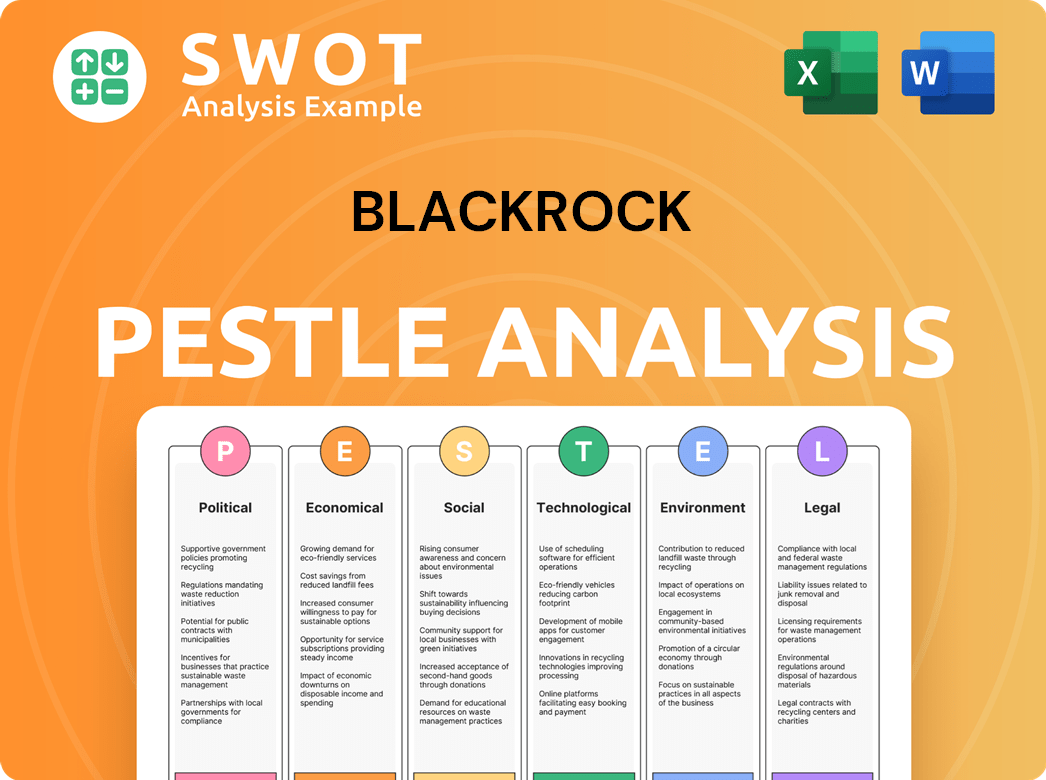
Who Sits on BlackRock’s Board?
The current board of directors at BlackRock includes a blend of executive and independent directors. As of early 2025, the board is led by key figures such as Laurence Fink, who serves as Chairman and CEO, and Robert Kapito, the President. These individuals represent the company's executive leadership and its founding vision. The majority of the board is composed of independent directors, a standard practice for publicly traded companies. These independent directors contribute diverse expertise from various sectors and backgrounds, ensuring objective oversight and good governance.
The composition of the board reflects BlackRock's commitment to robust corporate governance. The presence of independent directors helps in maintaining a balance of perspectives and ensuring that the company's operations are conducted with integrity and in the best interests of all stakeholders. This structure is crucial for navigating the complexities of the financial market and maintaining investor confidence. The Growth Strategy of BlackRock highlights the importance of strong leadership and governance in driving the company's success.
| Board Member | Title | Role |
|---|---|---|
| Laurence D. Fink | Chairman and CEO | Executive Director |
| Robert S. Kapito | President | Executive Director |
| Murry S. Bowden | Lead Independent Director | Independent Director |
BlackRock operates under a one-share-one-vote structure. This means that each share of common stock generally grants its holder one vote on shareholder matters. There are no reports of dual-class shares or special voting rights that would give specific individuals or entities disproportionate control. While Larry Fink, as a founder and CEO, holds a significant individual stake, his voting power is directly proportional to his share ownership. Major institutional investors, due to their substantial shareholdings, collectively possess considerable voting power. They often exercise this influence through proxy voting on executive compensation, board elections, and corporate governance proposals. The increased focus on corporate governance and environmental, social, and governance (ESG) factors in recent years has led to more active engagement from large institutional shareholders during proxy season.
BlackRock's voting structure is straightforward: one share equals one vote, ensuring a fair distribution of voting rights among shareholders. The board includes executive and independent directors, promoting balanced oversight. Institutional investors have significant voting power, influencing key decisions.
- One-share-one-vote structure.
- Board composed of executive and independent directors.
- Institutional investors play a key role in proxy voting.
- Focus on ESG factors is increasing shareholder engagement.
BlackRock Business Model Canvas
- Complete 9-Block Business Model Canvas
- Effortlessly Communicate Your Business Strategy
- Investor-Ready BMC Format
- 100% Editable and Customizable
- Clear and Structured Layout
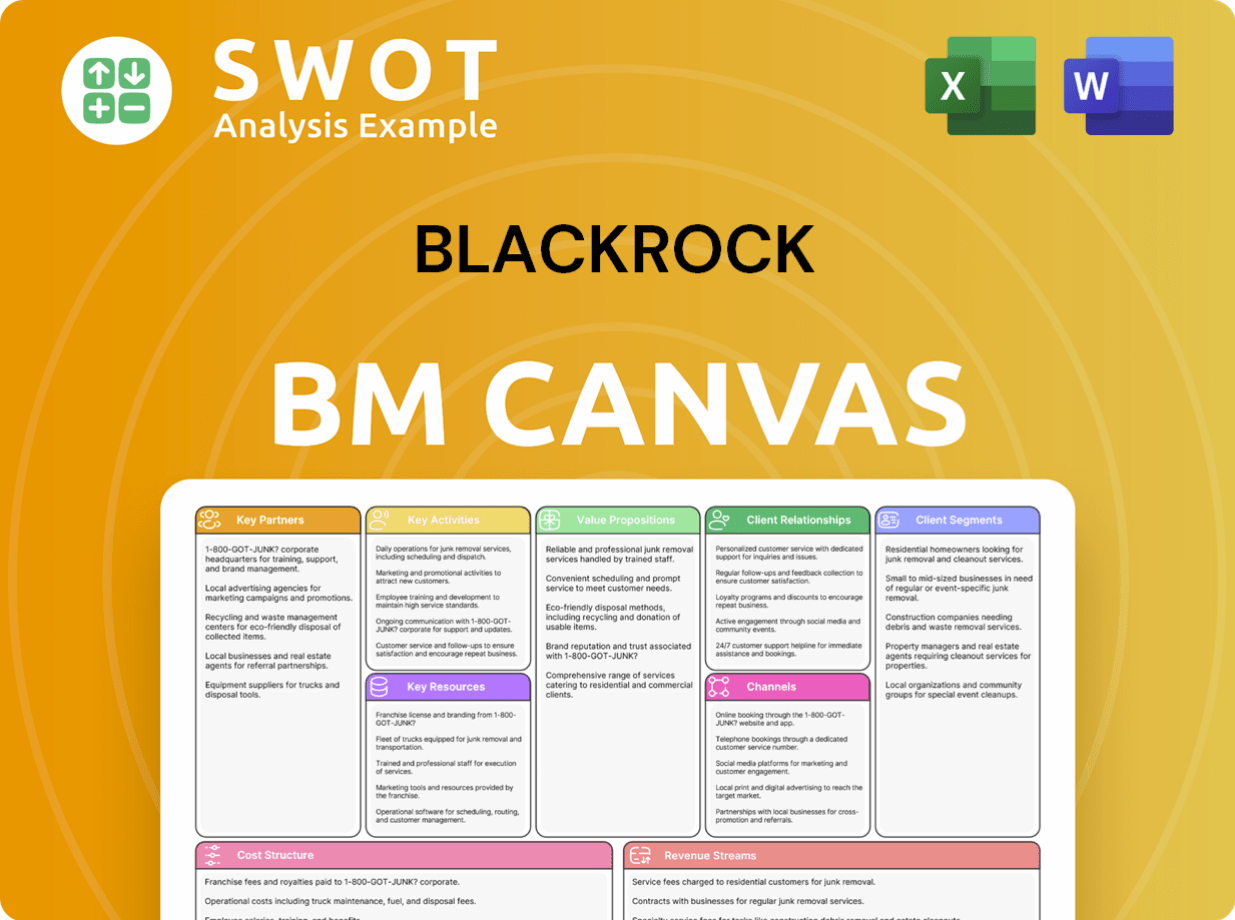
What Recent Changes Have Shaped BlackRock’s Ownership Landscape?
Over the past few years, the ownership landscape of BlackRock has seen some key shifts. The most notable trend is the increasing dominance of institutional investors. These investors, including passive index funds and ETFs, now hold a significant portion of BlackRock's shares. This reflects a broader market trend towards passive investing, where BlackRock itself is a major player. Understanding BlackRock's marketing strategy provides additional context to its market influence and shareholder dynamics.
Share buyback programs remain a consistent part of BlackRock's financial strategy. These programs can increase the ownership percentage of the remaining shareholders. While there haven't been major changes in the founding leadership, the company continues to expand globally. This expansion can lead to changes in investor sentiment and trading activity. BlackRock's focus on integrating sustainability into its investment strategies also attracts certain institutional investors.
| Shareholder | Approximate Ownership (as of late 2024) | Notes |
|---|---|---|
| Vanguard Group | ~7.5% | One of the largest institutional holders. |
| iShares (BlackRock) | ~5% | BlackRock's own ETFs. |
| State Street Corporation | ~4% | Another significant institutional investor. |
BlackRock's ownership structure is characterized by a high degree of institutional ownership. The company's financial performance and investment strategies are major factors influencing its share price. The stability of its institutional investor base is often highlighted, but the market's dynamic nature means that there are always shifts in the shareholder composition. The company's assets under management (AUM) and its ability to attract institutional investors are key indicators of its financial health and market influence.
The largest shareholders of BlackRock include Vanguard Group, BlackRock's own iShares funds, and State Street Corporation. These institutional investors collectively hold a significant portion of the company's shares, reflecting a trend towards passive investing.
Share buyback programs are a consistent part of BlackRock's capital allocation strategy. These buybacks can increase the ownership percentage of the remaining shareholders and signal confidence in the company's valuation. This strategy helps to maintain shareholder value.
Institutional investors, including passive index funds and ETFs, have increased their ownership of BlackRock. This trend is driven by the broader shift towards passive investing in the financial markets. These investors play a key role in shaping BlackRock's shareholder base.
BlackRock has been at the forefront of integrating sustainability considerations into its investment strategies. This approach attracts certain types of institutional investors and influences others, reflecting a growing focus on environmental, social, and governance (ESG) factors in investment decisions.
BlackRock Porter's Five Forces Analysis
- Covers All 5 Competitive Forces in Detail
- Structured for Consultants, Students, and Founders
- 100% Editable in Microsoft Word & Excel
- Instant Digital Download – Use Immediately
- Compatible with Mac & PC – Fully Unlocked
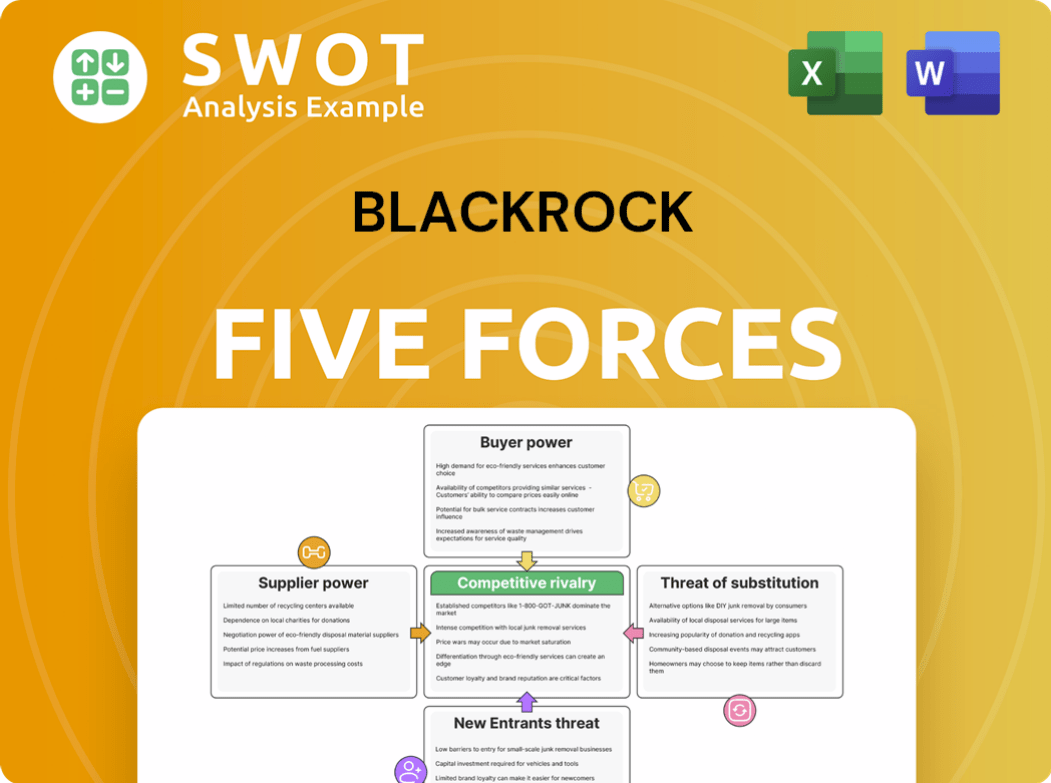
Related Blogs
- What are Mission Vision & Core Values of BlackRock Company?
- What is Competitive Landscape of BlackRock Company?
- What is Growth Strategy and Future Prospects of BlackRock Company?
- How Does BlackRock Company Work?
- What is Sales and Marketing Strategy of BlackRock Company?
- What is Brief History of BlackRock Company?
- What is Customer Demographics and Target Market of BlackRock Company?
Disclaimer
All information, articles, and product details provided on this website are for general informational and educational purposes only. We do not claim any ownership over, nor do we intend to infringe upon, any trademarks, copyrights, logos, brand names, or other intellectual property mentioned or depicted on this site. Such intellectual property remains the property of its respective owners, and any references here are made solely for identification or informational purposes, without implying any affiliation, endorsement, or partnership.
We make no representations or warranties, express or implied, regarding the accuracy, completeness, or suitability of any content or products presented. Nothing on this website should be construed as legal, tax, investment, financial, medical, or other professional advice. In addition, no part of this site—including articles or product references—constitutes a solicitation, recommendation, endorsement, advertisement, or offer to buy or sell any securities, franchises, or other financial instruments, particularly in jurisdictions where such activity would be unlawful.
All content is of a general nature and may not address the specific circumstances of any individual or entity. It is not a substitute for professional advice or services. Any actions you take based on the information provided here are strictly at your own risk. You accept full responsibility for any decisions or outcomes arising from your use of this website and agree to release us from any liability in connection with your use of, or reliance upon, the content or products found herein.